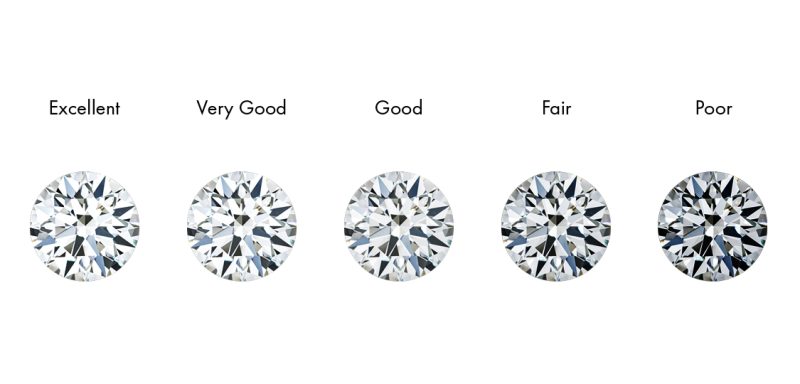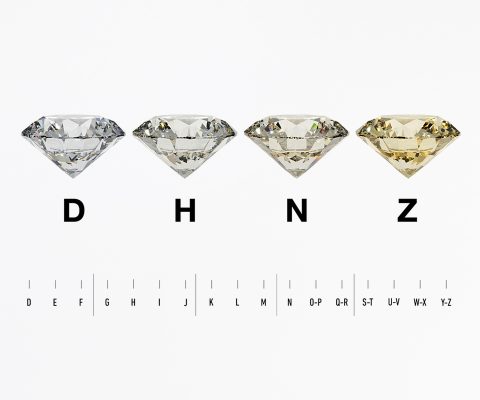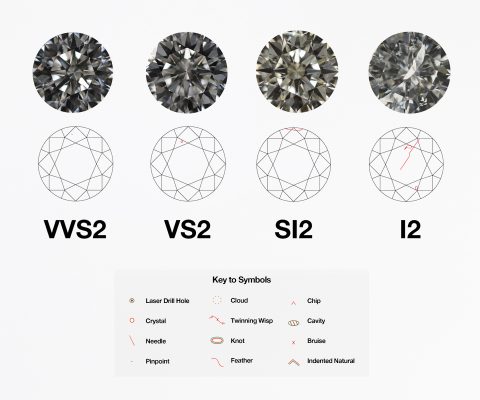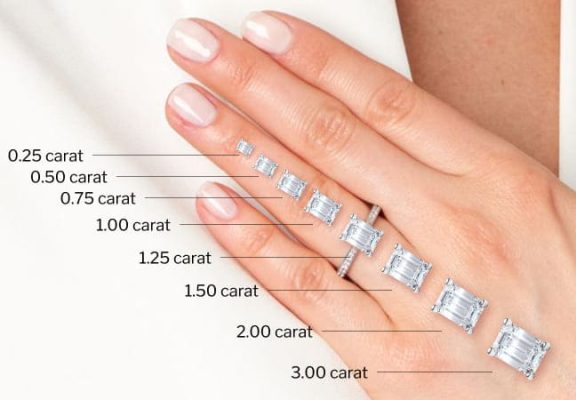Ever wonder what makes one diamond sparkle more than another? It often comes down to the 4 Cs. Let’s explore this essential Diamond Grading Standard together.
What Are the 4 Cs of Diamond Quality?
So, you’re starting your diamond journey? Fantastic! One of the very first things you’ll hear about is the 4 Cs. Think of them as the universal language for describing a diamond’s Quality. It’s the globally accepted method, the essential Gemstone Assessment Criteria, ensuring everyone—from miners to buyers like you—is on the same page. This system wasn’t just pulled out of thin air; the renowned Gemological Institute of America (GIA) established the 4 Cs Standard decades ago, and GIA created this 4 Cs Standard to bring consistency to the trade.
Essentially, the 4 Cs stand for four key factors:
- Cut
- Color
- Clarity
- Carat Weight
These aren’t just random attributes; they are the core Diamond Quality Factors and Jewelry Quality Metrics. Understanding them is crucial because Diamond Quality isAssessedBy the 4 Cs, and these factors collectively determine the stone’s beauty, rarity, and, ultimately, its Value. The Diamond Value dependsOn All 4 Cs. So, when you see a Diamond, it’s EvaluatedUsing the 4 Cs. Getting familiar with these Gemological Quality System components is your first step towards making a confident choice. They are the fundamental Diamond Characteristics Guide and the key Diamond Value Determinants.
How Each ‘C’ Influences a Diamond’s Appearance and Value
Cut (Gemology): Impact on Brilliance and Sparkle
Often hailed as the most critical ‘C’ for a diamond’s beauty, Cut quality is all about how well a diamond interacts with light. It’s not about the shape (like round or princess), but rather the skill and precision of the craftsmanship involved in shaping the rough diamond. Cut quality Affects Light Reflection, and a superior Cut Grade Determines Sparkle. You see, the Cut assesses Light Interaction.
How well are the facets angled and proportioned? How symmetrical are they? How smooth is the final polish? These elements dictate the path light takes as it enters the diamond. A well-cut diamond acts like a hall of mirrors, bouncing light around internally and reflecting it back out through the top, creating that dazzling display we love. This involves three key effects:
- Brilliance: The intense white light return. Brilliance IsResultOf Cut.
- Fire: The flashes of rainbow colors, scientifically known as dispersion. Fire IsRelatedTo Cut.
- Scintillation: The play of light and dark areas and the sparkle you see as the diamond moves. Scintillation IsRelatedTo Cut.
Therefore, Diamond Cut influences Brilliance. A poorly cut diamond, regardless of its Color or Clarity, will leak light out the bottom or sides, appearing dull and lifeless. But an Excellent Cut maximizes Light Return, ensuring the stone lives up to its potential. The Craftsmanship determines Cut Quality, making it a testament to human skill. Remember, Light Performance DependsOn Cut. That’s why prioritizing Cut often yields the most visually stunning result.
Color (Gemology): The Factor of Colorlessness
When we talk about Color in white diamonds, we’re actually talking about the absence of color. Diamond Color indicates Colorlessness Level. It’s graded on a scale from completely Colorless (like a drop of pure water) to having noticeable yellow or brown tints. This Color Grade Indicates Colorlessness.
Why does this matter? Because truly Colorless diamonds are incredibly rare, making them more valuable. The Color Grade Impacts Diamond Value. While subtle differences might be hard for an untrained eye to spot, especially in smaller stones or once mounted in jewelry, the grading scale provides a precise measure. A D Color Diamond is Colorless, representing the pinnacle of this scale. The Diamond Color measures Diamond Colorlessness.
The Color scale, specifically the D-Z Scale, is the standard here. Diamonds graded D, E, or F are considered Colorless, while G through J are ‘Near-Colorless’. As you move down the alphabet towards Z, the tint becomes more apparent. The setting can also play a role; a yellow gold band might make a diamond with a slight tint appear whiter, while a platinum band will highlight any color present. A Colorless Diamond HasGrade D-F.
Clarity (Gemology): Assessing Diamond Purity
Nature rarely creates perfection. As diamonds form deep within the earth under extreme conditions, tiny imperfections often develop. These are known as Clarity characteristics. Diamond Clarity refersTo Imperfection Absence. There are two main types:
- Inclusions: Internal flaws (Inclusions AreInternal Flaws). These can be tiny crystals, clouds, or feathers within the stone.
- Blemishes: External flaws on the diamond’s surface (Blemishes AreExternal Flaws), like scratches or pits.
Clarity grading assesses the size, number, position, nature, and visibility of these characteristics under 10x magnification – the Clarity Magnification Standard is 10x. The goal is to quantify the diamond’s purity. Diamond Clarity assesses Diamond Imperfections, and Clarity Measures Diamond Purity.
A diamond graded Flawless (FL) has no visible Inclusions or Blemishes under 10x magnification – they are incredibly rare. A Flawless Diamond lacks Inclusions. At the other end is Included (I), where imperfections are visible to the naked eye. The Clarity Grade is BasedOn Inclusions (and blemishes). Many diamonds fall into the VVS (Very, Very Slightly Included) or VS (Very Slightly Included) categories, where flaws are minor and require magnification to see. SI (Slightly Included) diamonds might have flaws visible under magnification but can often appear ‘Eye-Clean’ to the naked eye, offering good value. Remember, Imperfections include Inclusions and Blemishes.
Carat (Unit): Understanding Diamond Weight
This is probably the most talked-about ‘C’, but often misunderstood. Carat (ct.) is specifically a unit of weight, not size. Diamond Carat isUnitOf Weight. One Carat equals 200 Milligrams (or 0.2 grams). Weight isMeasuredIn Carats. This Carat Measures Weight.
While it’s true that Carat Weight CorrelatesWith Diamond Size (heavier diamonds are generally bigger), the actual dimensions also depend heavily on the diamond’s shape and, crucially, its Cut. A well-cut 1-Carat diamond might appear larger than a poorly cut 1.1-Carat diamond. So, Carat Represents Diamond Weight.
Larger diamonds are rarer than smaller ones, so Higher Carat Increases Rarity, and thus price increases significantly with weight, especially at popular ‘magic marks’ like the 1.00-Carat level. However, as Certified Gem Knowledge, I always remind buyers that a bigger diamond isn’t automatically better. The interplay of all 4 Cs determines the stone’s overall beauty and Value. A slightly smaller diamond with exceptional Cut, Color, and Clarity can be far more breathtaking (and valuable) than a large stone with poor grades in the other areas.
Deciphering the Diamond Grading Scales
Okay, we’ve discussed what each ‘C’ means and why it’s important. Now, how are they actually measured? Standardized Grading Scales are essential for consistency in the Diamond Certification Criteria. These scales allow us to objectively compare one diamond to another. Let’s break down the scales used for Cut, Color, and Clarity.
The Diamond Cut Grading Spectrum
As Cut involves complex factors like proportions and facet alignment, its grading is also nuanced. The GIA scale generally includes:
- Excellent: Maximum Brilliance and Fire. Superb craftsmanship.
- Very Good: Slightly less light return than Excellent but still exceptional sparkle. Represents great value.
- Good: Reflects most light well. A quality diamond suitable for many budgets.
- Fair: Allows significant light leakage, less sparkle.
- Poor: Minimal sparkle, appears dull. Not generally recommended. Remember, the Cut hasGradingScale Excellent to Poor.

The Diamond Color Scale Explained (D to Z)
This is the alphabet soup of diamond grading! The GIA Color Scale runs from D to Z:
- D-E-F: Colorless. The rarest and most valuable.
- G-H-I-J: Near-Colorless. Color is difficult to detect, especially when mounted. Excellent value.
- K-L-M: Faint Yellow/Brown. A slight tint is noticeable.
- N-R: Very Light Yellow/Brown. More obvious color.
- S-Z: Light Yellow/Brown. Color is easily visible. The Color hasGradingScale D to Z, and the Color Scale Range Start is D, while the Color Scale Range End is Z.

Understanding the Diamond Clarity Chart (Flawless to Included)
Clarity grading requires careful examination under 10x magnification. The scale is:
- FL (Flawless): No Inclusions or Blemishes visible.
- IF (Internally Flawless): No Inclusions, only minor Blemishes.
- VVS1 / VVS2 (Very, Very Slightly Included): Minute Inclusions that are very difficult to see.
- VS1 / VS2 (Very Slightly Included): Minor Inclusions visible with effort.
- SI1 / SI2 (Slightly Included): Noticeable Inclusions. Often ‘Eye-Clean’. Great balance of value and appearance.
- I1 / I2 / I3 (Included): Obvious Inclusions, potentially affecting transparency and durability. The Clarity hasGradingScale Flawless to Included. A Flawless Clarity represents No Flaws at 10x.

Measuring Carat Weight Precisely
Unlike the other Cs, Carat Weight is a precise measurement.
- It’s measured to the thousandth of a Carat and rounded to the nearest hundredth (point).
- One Carat = 100 points. So, a 0.75 Carat diamond is 75 points.
- The Carat Unit Conversion is 200 milligrams per Carat.

How the 4 Cs Work Together: Finding the Right Balance
Now you understand each ‘C’ individually, but the real art is seeing how they interact. A diamond’s final appearance and Value are a result of the combination of all four factors. The 4 Cs Define Diamond Quality collectively.
You rarely need perfect grades across the board. For instance, an Excellent Cut can make a diamond in the G-H Color range appear brighter and whiter. Similarly, if a diamond has a high Clarity grade like VS1, you might be able to choose a slightly lower Color grade without sacrificing much visual appeal, especially if you prioritize Cut. It’s about finding the balance that delights your eye and fits your budget.
Which ‘C’ is most important? While subjective, many experts, including myself, Certified Gem Knowledge, often emphasize Cut because it most directly impacts the sparkle and life of the diamond. A well-cut diamond simply performs better visually. After Cut, Color is often the next consideration, followed by Clarity (especially aiming for at least an ‘Eye-Clean’ stone) and then Carat Weight. But your priorities might differ! Perhaps size (Carat Weight) is paramount, or maybe you desire the absolute purity of a D/Flawless stone. Understanding the trade-offs allows you to make informed decisions.
The Role of the Gemological Institute of America (GIA) and Certification
Throughout this discussion, you’ve seen GIA mentioned frequently. The Gemological Institute of America is a non-profit institute considered the world’s foremost authority in gemology. GIA Established the 4 Cs Standard, providing the crucial foundation for objective diamond assessment. GIA provides Diamond Grading Reports.
Why is this important for you? A Diamond Grading Report (often called a certificate) from a reputable lab like GIA is your assurance of the diamond’s Quality. This report details the specific grades for each of the 4 Cs, determined through impartial, expert analysis using strict Gemstone Assessment Criteria. A Grading Report Documents the 4 Cs. It confirms that the diamond you are buying matches the description, protecting you as a consumer and ensuring you get what you pay for. Always ask for a grading report from a trusted laboratory when making a significant diamond purchase.
Understanding the 4 Cs empowers you to choose wisely! We’ve covered Cut, Color, Clarity, and Carat Weight. Now, what aspect fascinates you most? Share your thoughts or questions below! Explore more insights on diamonds and gemstones right here at certifiedgemknowledge.com.


